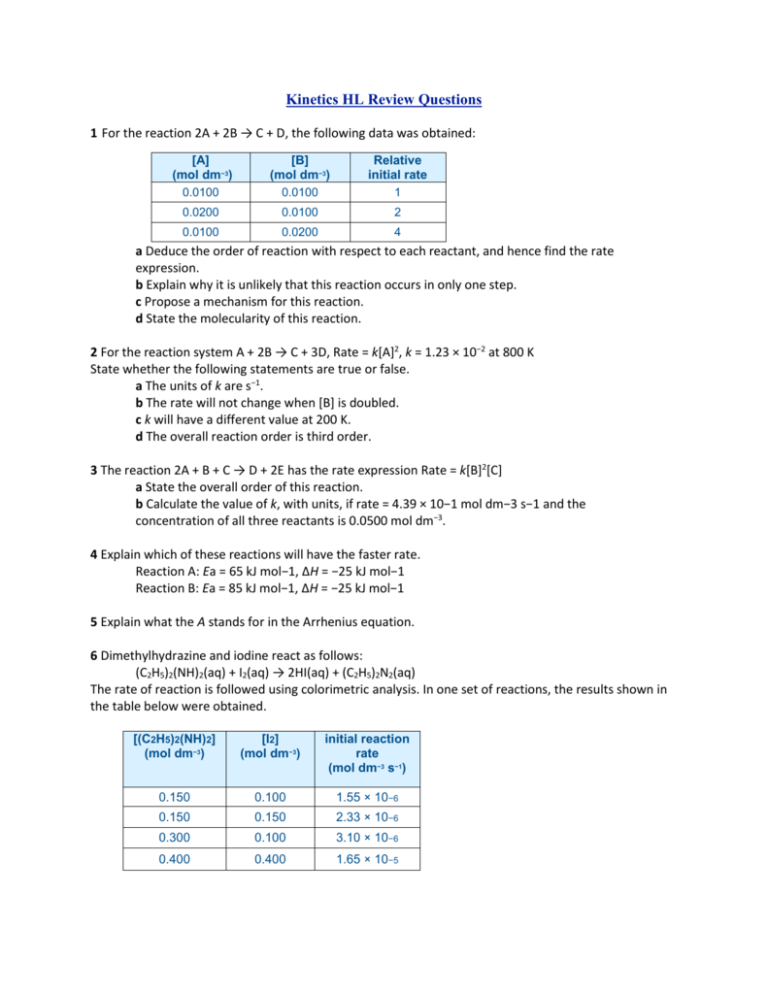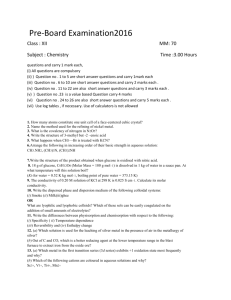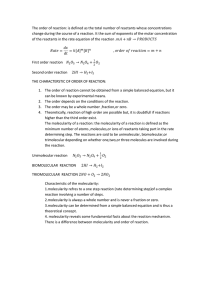Kinetics HL
advertisement

Kinetics HL Review Questions 1 For the reaction 2A + 2B → C + D, the following data was obtained: [A] (mol dm−3) 0.0100 [B] (mol dm−3) 0.0100 Relative initial rate 1 0.0200 0.0100 2 0.0100 0.0200 4 a Deduce the order of reaction with respect to each reactant, and hence find the rate expression. b Explain why it is unlikely that this reaction occurs in only one step. c Propose a mechanism for this reaction. d State the molecularity of this reaction. 2 For the reaction system A + 2B → C + 3D, Rate = k[A]2, k = 1.23 × 10−2 at 800 K State whether the following statements are true or false. a The units of k are s−1. b The rate will not change when [B] is doubled. c k will have a different value at 200 K. d The overall reaction order is third order. 3 The reaction 2A + B + C → D + 2E has the rate expression Rate = k[B]2[C] a State the overall order of this reaction. b Calculate the value of k, with units, if rate = 4.39 × 10−1 mol dm−3 s−1 and the concentration of all three reactants is 0.0500 mol dm−3. 4 Explain which of these reactions will have the faster rate. Reaction A: Ea = 65 kJ mol−1, ΔH = −25 kJ mol−1 Reaction B: Ea = 85 kJ mol−1, ΔH = −25 kJ mol−1 5 Explain what the A stands for in the Arrhenius equation. 6 Dimethylhydrazine and iodine react as follows: (C2H5)2(NH)2(aq) + I2(aq) → 2HI(aq) + (C2H5)2N2(aq) The rate of reaction is followed using colorimetric analysis. In one set of reactions, the results shown in the table below were obtained. [(C2H5)2(NH)2] (mol dm−3) [I2] (mol dm−3) initial reaction rate (mol dm−3 s−1) 0.150 0.100 1.55 × 10−6 0.150 0.150 2.33 × 10−6 0.300 0.100 3.10 × 10−6 0.400 0.400 1.65 × 10−5 a Deduce the order of reaction with respect to each reactant, and hence find the rate expression. b Calculate k. c Propose a mechanism for this reaction. d Given the mechanism you proposed in part c, deduce the molecularity of this reaction. 7 Consider the reaction 2NO(g) + O2(g) → 2NO2(g) with the rate expression Rate = k[NO]2[O2]. a Describe how the initial rate of reaction compares with the rate when the NO concentration has decreased by half. b State the molecularity of this reaction c Explain whether this could be a one-step process. d Describe the effect that heating the system would have on the value of k. 8 a Calculate the fraction of molecules having energy in excess of 120 kJ in a gas sample at 300°C. b Describe how the fraction changes when the temperature is increased by 20°C. 9 a Propose two different mechanisms for the reaction A + 2B + C → D + 2E given that Rate = k[A][B]. b State the molecularity of this reaction. 10 Consider the following reaction: H2(g) + 2ICl(g) → 2HCl(g) + I2(g); Rate = k[H2][ICl] a State the molecularity of the reaction. b Propose a two-step mechanism. c Identify any intermediates in your proposed mechanism. 11 Explain whether an elementary step can ever be identical to the overall reaction equation. 12 Explain whether the Arrhenius equation can be applied to reactions of any order, or only to first order reactions. 13 The reaction A + B + C → D + E was found to be zero order with respect to A and second order with respect to B. a Sketch the shape of the rate–concentration graph with respect to A. b Sketch the shape of the concentration–time graph with respect to B. c Derive the rate expression for this reaction. d Propose a mechanism for this reaction, identifying the rate-determining step. 14 Explain why the units of k are different for each reaction order. 15 The following rate–concentration graph is for the reaction 2A → C + D. From the graph, deduce the order of this reaction and hence write the rate expression. Show all working and reasoning. 16 The reaction of 2-methyl-2-chloropropane with hydroxide ions forming 2-methyl-2-propanol (isobutanol) and chloride ions is a two-step process: Step 1: CH3C(CH3)2Cl → CH3C+(CH3)2 + Cl− Rate = k1[CH3C(CH3)2Cl] Step 2: CH3C+(CH3)2 + OH−→ CH3C(CH3)2OH Rate = k2[CH3C+(CH3)2][OH−] k2 > k1 a Identify the rate-determining step. b State the molecularity of step 1. 17 Identify two factors that will change the value of k for a particular reaction. 18 A first-order elementary reaction of the type A → products has k = 5.43 × 10−4 s−1 at 250°C and Ea = 27 kJ mol−1. a Calculate the value of the Arrhenius constant. b Calculate the value of k when T = 800 K. c Determine the absolute temperature when k = 2.13 × 10−6 s−1. 19 For a graph of ln k versus 1/T, find the value of the gradient. 20 The temperature dependence of the rate constant of the reaction CO(g) + NO2(g) → CO2(g) + NO(g) is shown in the table below. Temperature (°C) Rate constant k (mol-1 dm3 s-1) 327 2.8 x 10-2 427 1.3 527 23 Use these values to calculate the values of Ea and the Arrhenius constant for this reaction.










